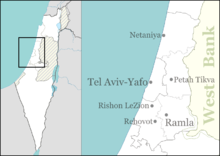Ayalon Cave
You can help expand this article with text translated from the corresponding article in German. (September 2014) Click [show] for important translation instructions.
|
You can help expand this article with text translated from the corresponding article in Russian. (April 2015) Click [show] for important translation instructions.
|
| Ayalon Cave | |
|---|---|
 Large chamber with cave lake in Ayalon Cave | |
| Location | Ramla, Israel |
| Depth | 100 metres (330 ft) |
| Length | 2,700 metres (8,900 ft) |
| Discovery | 2006 |
| Geology | Limestone |
The Ayyalon Cave (Hebrew: מערת איילון) is a large underground limestone cave near Ramla, Israel in which new species of crustaceans were discovered in April 2006.[1] What makes the cave extremely interesting to science are two elements. One is that its complex food web survived for millions of years without light or organic food coming in from the surface, being based solely on a type of bacterium which feeds on sulfur and is the only organic matter available for the next higher level of organisms to feed on. The other is the fact that the cave has offered an ecological refuge for species whose relatives living at the surface have been wiped out by climatic changes and catastrophic events over millions of years, so that it now offers a unique sample for the study of long-term ecological changes in the area.[2]
The cave is not accessible to the public. Only a small group of researchers are allowed to enter.[2]
Name
In scientific literature the cave is known as the Ayyalon Cave. In the press it might be spelled as "Ayalon Cave", and has also been dubbed "the Noah's Ark cave", as it offered animal species a survival niche and it is located in the "land of the Bible".
History
The cave was discovered in 2006 when a small opening was discerned in a quarry near Ramla.
Description
The cave, 100 metres (330 ft) deep, extends 2,700 metres (8,900 ft) including its branches, which makes it the third-largest limestone cave in Israel.[2] According to Professor Amos Frumkin of the Hebrew University, the cave is unique in that a thick layer of chalk left it impermeable to any water coming from the surface.
Ecosystem
Researchers announced that they have so far discovered eight species previously unknown to science, all without eyes, comprising four aquatic crustacean species and four other species of terrestrial crustaceans and springtails.[2] They added that the crustaceans included two seawater and two fresh water species, this diversity giving hope that it might help better understand the water history of the region.
Unfortunately, a species of eyeless troglobitic scorpion representing a taxonomic family previously unknown to science, has been discovered only a decade or so after its extinction. This was probably caused by overpumping of the ground water, which has led the underground lake to shrink, and with it the food supply to dwindle. The ten specimen found dead in the cave are exceptionally well preserved and allowed the conclusion that they used a motion detecting organ situated on their abdomen for orientation. The species was given the name fr, from the Hebrew word for scorpion, "akrav", and honouring the researchers who identified it, Israel Naaman and Hanan Dimentman.[2]
As the cave was completely cut off from the outside environment, it sustained an independent ecosystem; this ecosystem relied for an energy source neither on sunlight and photosynthesis, nor on an external source of organic compounds. Rather, energy was extracted by chemoautotrophic bacteria, living in a film on top of the water of an underground lake. These bacteria produce energy by oxidizing the sulfide compounds in the water, and derive organic compounds using carbon dioxide from the air. These compounds form the basis of the cave's ecosystem. The temperature and salt content of the cave's water indicates that it originates from sources deep underground. Although this cave is part of an aquifer fed by rain falling in the mountains to the east, which happens to be one of the main potable water sources for Israel and the Palestinian territories, chemically more complex sources can create local pockets with very specific water composition.
See also
- Typhlocaris galilea, a cave-dwelling blind shrimp and relative of one of the Ayyalon Cave species, found only in a spring near the Sea of Galilee in Israel
- Geography of Israel
- Wildlife of Israel
References
- ^ The Hebrew University Press release announcing the discovery
- ^ a b c d e "One year later, 'Noah's Ark' cave is no longer a safe haven". Haaretz. 19 July 2007. Retrieved May 6, 2009.
External links
- National Geographic
- A. Frumkin and H. Gvirtzman (2006). "Cross-formational rising groundwater at an artesian karstic basin: the Ayalon Saline Anomaly, Israel" (PDF). Journal of Hydrology. 318 (1–4): 316–333. doi:10.1016/j.jhydrol.2005.06.026.

